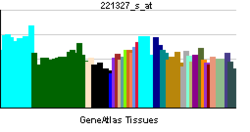OPN1LW
Изглед
| Opsin 1, senzitivan na dugačke talasne dužine | |||||||||||
|---|---|---|---|---|---|---|---|---|---|---|---|
| Identifikatori | |||||||||||
| Simboli | OPN1LW; CBP; CBBM; RCP | ||||||||||
| Vanjski ID | OMIM: 303900 MGI: 1097692 HomoloGene: 68064 GeneCards: OPN1LW Gene | ||||||||||
| |||||||||||
| Pregled RNK izražavanja | |||||||||||
 | |||||||||||
| podaci | |||||||||||
| Ortolozi | |||||||||||
| Vrsta | Čovek | Miš | |||||||||
| Entrez | 5956 | 14539 | |||||||||
| Ensembl | ENSG00000102076 | ENSMUSG00000031394 | |||||||||
| UniProt | P04000 | O35599 | |||||||||
| RefSeq (mRNA) | NM_020061 | NM_008106 | |||||||||
| RefSeq (protein) | NP_064445 | NP_032132 | |||||||||
| Lokacija (UCSC) |
Chr X: 153.06 - 153.08 Mb |
Chr X: 70.38 - 70.4 Mb | |||||||||
| PubMed pretraga | [1] | [2] | |||||||||
OPN1LW, crveno-senzitivni opsin, je protein koji je kod ljudi kodiran OPN1LW genom.[1]
Ovaj gen kodira pigment iz familije opsina koji apsorbuje svetlost. On se naziva crveni fotopigment kupastih ćelija, ili opsin senzitivan na dugačke talasne dužine. Opsini su grupa G-protein spregnutih receptora sa sedam transmembranskih domena, ekstracelularnim N-terminusnim domenom, i citosolnim C-terminusom. Ovaj gen i opsinski geni srednjih-talasnih dužina su grupisani na X hromozomu. Česte neravnomerne rekombinacije i konverzije gena se mogu javiti između tih sekvenci. X hromozomi mogu da imaju spajanja gena opsina srednje i duge talasne dužine, ili višestruke kopije tih gena. Defekti ovog gena su uzrok parcijalne slepoće za boje.[1]
Vidi još
[уреди | уреди извор]Literatura
[уреди | уреди извор]Dodatna literatura
[уреди | уреди извор]- Applebury ML, Hargrave PA (1987). „Molecular biology of the visual pigments.”. Vision Res. 26 (12): 1881—95. PMID 3303660. doi:10.1016/0042-6989(86)90115-X.
- Winderickx J; Lindsey DT; Sanocki E; et al. (1992). „Polymorphism in red photopigment underlies variation in colour matching.”. Nature. 356 (6368): 431—3. PMID 1557123. doi:10.1038/356431a0.
- Dietrich A, Korn B, Poustka A (1992). „Completion of the physical map of Xq28: the location of the gene for L1CAM on the human X chromosome.”. Mamm. Genome. 3 (3): 168—72. PMID 1617223. doi:10.1007/BF00352462.
- Arveiler B, Vincent A, Mandel JL (1989). „Toward a physical map of the Xq28 region in man: linking color vision, G6PD, and coagulation factor VIII genes to an X-Y homology region.”. Genomics. 4 (4): 460—71. PMID 2501212. doi:10.1016/0888-7543(89)90269-3.
- Nathans J, Thomas D, Hogness DS (1986). „Molecular genetics of human color vision: the genes encoding blue, green, and red pigments.”. Science. 232 (4747): 193—202. PMID 2937147. doi:10.1126/science.2937147.
- Adams MD; Kerlavage AR; Fleischmann RD; et al. (1995). „Initial assessment of human gene diversity and expression patterns based upon 83 million nucleotides of cDNA sequence.”. Nature. 377 (6547 Suppl): 3—174. PMID 7566098. doi:10.1038/377003a0.
- Li ZY, Kljavin IJ, Milam AH (1995). „Rod photoreceptor neurite sprouting in retinitis pigmentosa.”. J. Neurosci. 15 (8): 5429—38. PMID 7643192.
- Chen J; Tucker CL; Woodford B; et al. (1994). „The human blue opsin promoter directs transgene expression in short-wave cones and bipolar cells in the mouse retina.”. Proc. Natl. Acad. Sci. U.S.A. 91 (7): 2611—5. PMC 43419
 . PMID 8146162. doi:10.1073/pnas.91.7.2611.
. PMID 8146162. doi:10.1073/pnas.91.7.2611. - Nathans J; Maumenee IH; Zrenner E; et al. (1993). „Genetic heterogeneity among blue-cone monochromats.”. Am. J. Hum. Genet. 53 (5): 987—1000. PMC 1682301
 . PMID 8213841.
. PMID 8213841. - Ladekjaer-Mikkelsen AS, Rosenberg T, Jørgensen AL (1996). „A new mechanism in blue cone monochromatism.”. Hum. Genet. 98 (4): 403—8. PMID 8792812. doi:10.1007/s004390050229.
- Ferreira PA, Nakayama TA, Pak WL, Travis GH (1996). „Cyclophilin-related protein RanBP2 acts as chaperone for red/green opsin.”. Nature. 383 (6601): 637—40. PMID 8857542. doi:10.1038/383637a0.
- Voegel JJ; Heine MJ; Tini M; et al. (1998). „The coactivator TIF2 contains three nuclear receptor-binding motifs and mediates transactivation through CBP binding-dependent and -independent pathways.”. EMBO J. 17 (2): 507—19. PMC 1170401
 . PMID 9430642. doi:10.1093/emboj/17.2.507.
. PMID 9430642. doi:10.1093/emboj/17.2.507. - Zhao Z, Hewett-Emmett D, Li WH (1998). „Frequent gene conversion between human red and green opsin genes.”. J. Mol. Evol. 46 (4): 494—6. PMID 9541545. doi:10.1007/PL00013147.
- Nakayama TA, Zhang W, Cowan A, Kung M (1999). „Mutagenesis studies of human red opsin: trp-281 is essential for proper folding and protein-retinal interactions.”. Biochemistry. 37 (50): 17487—94. PMID 9860863. doi:10.1021/bi982077u.
- John SK, Smith JE, Aguirre GD, Milam AH (2000). „Loss of cone molecular markers in rhodopsin-mutant human retinas with retinitis pigmentosa.”. Mol. Vis. 6: 204—15. PMID 11063754.
- Ueyama H; Kuwayama S; Imai H; et al. (2002). „Novel missense mutations in red/green opsin genes in congenital color-vision deficiencies.”. Biochem. Biophys. Res. Commun. 294 (2): 205—9. PMID 12051694. doi:10.1016/S0006-291X(02)00458-8.
- Fitzgerald KA; Rowe DC; Barnes BJ; et al. (2003). „LPS-TLR4 signaling to IRF-3/7 and NF-kappaB involves the toll adapters TRAM and TRIF.”. J. Exp. Med. 198 (7): 1043—55. PMC 2194210
 . PMID 14517278. doi:10.1084/jem.20031023.
. PMID 14517278. doi:10.1084/jem.20031023. - Long J; Wang G; Matsuura I; et al. (2004). „Activation of Smad transcriptional activity by protein inhibitor of activated STAT3 (PIAS3).”. Proc. Natl. Acad. Sci. U.S.A. 101 (1): 99—104. PMC 314145
 . PMID 14691252. doi:10.1073/pnas.0307598100.
. PMID 14691252. doi:10.1073/pnas.0307598100. - Ross MT; Grafham DV; Coffey AJ; et al. (2005). „The DNA sequence of the human X chromosome.”. Nature. 434 (7031): 325—37. PMC 2665286
 . PMID 15772651. doi:10.1038/nature03440.
. PMID 15772651. doi:10.1038/nature03440.
